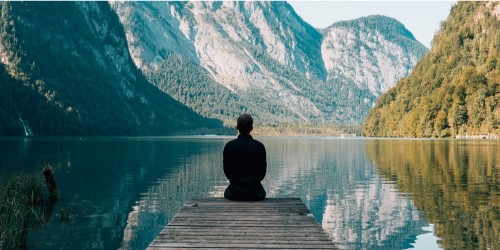
In the heart of yoga, Mary Paffard‘s journey unfolds like a rich tapestry woven from diverse influences. From her early days with Iyengar yoga in London to a seasoned practitioner and teacher, Mary discusses the evolution of her practice, the nuances of her teaching philosophy, and the profound impact of yoga on the individual, community, and the environment. Lean more in her exclusive MysticMag interview below.
How did you get into yoga and what sparked your interest in it?
I was dragged kicking and chain-smoking into yoga when I was a late teenager in college in London, as I’m English. I was in dire straits – too much coffee and too many other things that students tend to do, including many late nights. Yoga was a revelation to me. A friend of mine took me to a local class. At that time, in the early ‘70s, we were very lucky to have the Inner London Education Authority sponsoring yoga classes. They were very reasonably priced and accessible to everybody. The system of yoga that they supported was Iyengar yoga. That’s where my yoga journey started and it’s where I got my early training.
Over the years, I have evolved. There are still obviously some threads of the Iyengar there, but my practice now would be unrecognizable to the young woman at the beginning of my yoga journey. It’s very much inspired by other body-mind practices – Continuum dance forms, Body-Mind Centering, as well as by artists, musicians, writers, authors, and Buddhist meditation and philosophy. Those influences have been very important in my evolution as a practitioner and teacher.
What does your private coaching focus on?
I tend to be someone who really enjoys the public arena and teaching in groups. However, I do sometimes work with individuals, and I have an online program right now called “One-2-One,” which is 3 sessions spread over three months. It involves an hour and a half with me – we have some discussion time, we do a practice, we have a little review time, and then the practitioner takes that and works with it during the month. Then we see what’s happened.
I like to do three sessions. Very occasionally, I might do one session because I really feel that yoga’s a conversation, and, while I bring my experience and my knowledge, it’s very much about what that individual needs and where they’re at in the seasons of their lives. I am simply there to support that process.
What do your classes look like and is there a practical difference between online and offline ones?
In a typical class, we often have a theme. In my online classes right now, we have a theme called Reflection. Sometimes it’s a focus on a body part, sometimes it’s an image from poetry or the visual arts, etc. I weave the classes around that theme. The actual individual class may begin with a short meditation introducing the theme. It sometimes may include a poem, but not always. Then we usually start slowly. In my early years, I had a very vigorous practice, but now I find that yoga works in wonderful and mysterious ways, and one doesn’t need to do 108 sun salutes to touch all the bases.
We usually begin with the breath, simple sitting, reclining poses, and then we gradually move into more of a flow series, sometimes weaving in Surya Namaskar (sun salute), sometimes standing poses, but it’s not a very traditional approach. There are often movements that perhaps people would associate more with dance that are included in the classes.
I love to bring in inversions. I am really wedded to inversions if they’re practiced safely. Usually, most of my inversion teaching is in a retreat or an in-person situation. Occasionally, I work to include that option in an online class. Backbends are also always important. It can be very subtle backbends, but it may sometimes include more active ones. Then we usually have seated poses, a gentle cooldown, a relaxation, and sometimes a meditation at the end.
It really depends on the class. I do a lot of different types of workshops. Currently, I am preparing a Winter Solstice workshop and often bring the seasonal shifts into the practice. Sometimes I have a very strong anatomical theme coming up, for example, focusing on the piriformis and the external rotators, the shoulder joint, or understanding the natural breath, but most of my work is evolved around supporting the natural rhythms of the body, not just trying to get to our greatest potential, whatever that might be, but seeing how the rhythms of the breath and simple easeful movement can support an active, healthy, and heart-filled life.
What are your retreats like?
I used to teach a lot of retreats with friends of mine like Rodney Yee, Baxter Bell, and Barbara Benagh, quite well-known teachers in the Iyengar world. This was back in the early ’90s, in Hawaii, Costa Rica, and Mexico, as well as teaching in Europe sometimes. On that note, I still teach in Europe, but I do many fewer retreats than before, partly because traveling all over the world doesn’t seem to be very climate-supportive. I try to do things as much locally as possible.
My main retreat of the year is a Summer Solstice retreat here in the Mendocino County area. People have been coming to that retreat for, I think, over two decades now. We have very familiar faces, and we also have new folks coming in. They’re always people who want to be in a natural setting, to have some time in silence, but to also have some collective time for discussion, reflection, and obviously quite a lot of practice time.
We often start with a quiet/silent meditation, usually initiated with a poem or a particular image as fitting the theme. We often have the morning in silence. Then we have a long Asana practice, obviously breakfast and lunch interwoven, and some free time. In the afternoon, we usually have a gentle or restorative practice. In the evening, sometimes it’s just social time, but sometimes we do mandalas together or one of the students will offer a chanting session. Sometimes it’s just hanging out in the hot tub and catching up, but they’re always extremely delightful, and I feel that those are the places where people find their ground, their communities, truly deepen their practice, and whether the storms of life.
What other services do you offer?
I am very interested in the climate situation, and I do some volunteer work locally at times. This area is at a very high risk of fire, so much of my time is preoccupied with that. Also, I live on a collective property, looking after my community, my daughter, my grandchildren, my partner, and our apple orchard. I have also been involved in a program called Buddhist Eco-Chaplaincy. I am getting into discussions more and more, trying to support people at the front lines of activism, people at places where I might be less likely to be myself in terms of protests and serious direct action being taken.
I see myself as helping to support these communities more and helping people who are getting burnt out, fried, and needing reminders of why they are doing the work they are doing. Some sense of respite and embodiment. This focus on ecology sees the body as so much bigger than this individual human body. It also recognizes that the individual – not just in climate justice but eco-social justice as well – needs support and encouragement through yoga meditation and reflection in the natural world.
One of the projects that I’ve been involved in for many years is a volunteer project in Cuba – www.yogava.org. For over two decades, some of my friends and I have been supporting yoga and meditation communities there and bringing trainings to Cuba. Also, when we could, when it wasn’t illegal, we were bringing Cubans here who are naturally extraordinary teachers. They have such a strong cultural background and are dedicated practitioners. I have found being part of their communities and with our colleagues in Mexico, Argentina, Costa Rica, and Spain, a great privilege and inspirational for my own practice. We do our best to help keep that project alive and will be doing a fundraiser very soon for a Cuban who’s experienced extremely hard times and has also done a lot of good work bringing communities together in Cuba. Life is very challenging there these days and we need their voices, their incredible creativity, and resilience to touch our lives, as well.
To learn more about Mary and her work, you can visit www.maryyoga.com



